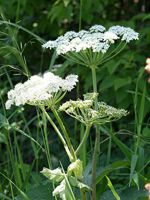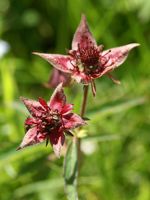Mon-Fri 9am - 5pm Mountain time
Marsh Cinquefoil vs Cow Parsnip
Heracleum maximum
Comarum palustre
CUSTOM GROW
CUSTOM GROW
Cow Parsnip is a native perennial wildflower known for its tall growth, very large leaves, and broad clusters of white flowers. The abundant blossoms provide nectar and pollen for a wide variety of pollinators, including bees and butterflies. Birds and small mammals feed on its seeds, while the foliage serves as a larval host for certain butterfly species.
Cow Parsnip is often among the first native perennials to establish in disturbed or open sites. It typically grows in moist meadows, along streambanks, forest edges, and roadsides. Although usually a short-lived perennial or biennial, it readily self-seeds and maintains strong populations where conditions are favorable.
Cow Parsnip is the only native Heracleum in North America and should not be confused with the highly invasive Giant Hogweed (H. mantegazzianum).
Note: The sap of the Cow Parsnip can cause phytodermatitis when exposed to ultraviolet light (sunlight). This can cause rashes or even burns. Care should be taken if pruning or handling this plant.
Marsh Cinquefoil is a native perennial wetland plant with striking reddish-purple, star-shaped flowers. They bloom in early to mid-summer, providing nectar for bees, flies, and other pollinators. Beyond its summer blooms, the foliage turns red in autumn, adding seasonal interest to wetland landscapes.
Common in wetlands, pond margins, and wet meadows, Marsh Cinquefoil spreads by rhizomes to form colonies or patches that contribute to shoreline stabilization. It thrives in nutrient-poor, saturated soils where many other plants struggle, making it valuable in challenging wetland conditions. With its ecological function and ornamental appeal, it is well-suited for wetland plantings, ecological restoration, and naturalized projects.
Cow Parsnip Quick Facts
Marsh Cinquefoil Quick Facts
Toxicity: sap causes skin irritation

